Abstract
Purpose
Time-dependent surgical instrument contamination and the effect of covering during arthroplasty have not been investigated. This study aimed to evaluate time-dependent contamination of surgical instruments and the effect of covering on contamination as well as to perform bacterial typing of contaminated samples. The hypothesis was that covering the surgical instruments would decrease contamination rates.
Methods
Sixty patients who underwent total knee arthroplasty were randomized and divided into two groups: surgical instruments covered with a sterile towel or surgical instruments left uncovered. K-wires were used to extract microbiological samples. The K-wires were placed in a liquid culture medium at 0, 15, 30, 60, 90, and 120 min. After 24-h incubation period, samples from liquid cultures were cultured on blood agar using swabs. Samples with growth after 48 h were considered contaminated. Microscopic, staining, and biochemical properties were used for bacterial typing.
Results
Bacterial growth started after 30 and 60 min in the uncovered and covered groups, respectively. An increase in the number of K-wires contaminated with time was detected. At least 10,000 CFU/mL bacterial load was observed in the culture samples. Contamination was more significant in the uncovered group. A statistically significant difference in contamination was found between the uncovered and covered groups at 30-, 60-, 90-, and 120 min (p = 0.035, p = 0.012, p = 0.024, and p = 0.037, respectively). The most common bacteria on the contaminated instruments were coagulase-negative Staphylococci (60.4%), Staphylococcus aureus (22.9%), and Streptococcus agalactia (16.7%), respectively.
Conclusion
The risk of contamination increases with time. However, it may decrease if surgical instruments are covered. In the clinical practice, empiric antibiotic regimens based on the type of identified microorganisms in this study may be developed for postoperative periprosthetic joint infection prophylaxis.
Level of evidence
Prognostic, Level II.


Similar content being viewed by others
References
Alamanda VK, Springer BD (2018) Perioperative and modifiable risk factors for periprosthetic joint infections (PJI) and recommended guidelines. Curr Rev Musculoskelet Med 11(3):325–331
Alamanda VK, Springer BD (2019) The prevention of infection 12: modifiable risk factors. Bone Joint J 101-B(1 Suppl A):3–9
Badawy M, Espehaug B, Fenstad AM, Indrekvam K, Dale H, Havelin LI, Furnes O (2017) Patient and surgical factors affecting procedure duration and revision risk due to deep infection in primary total knee arthroplasty. BMC Musculoskelet Disord 18(1):544
Bible JE, O’Neill KR, Crosby CG, Schoenecker JG, McGirt MJ, Devin DJ (2013) Implant contamination during spine surgery. Spine J 13(6):637–640
Campbell DA Jr, Henderson WG, Englesbe MJ, Hall BL, O’Reilly M, Bratzler D, Dellinger EP, Neumayer L, Bass BL, Hutter MM, Schwartz J, Ko C, Itani K, Steinberg SM, Siperstein A, Sawyer RG, Turner DJ, Khuri SF (2008) Surgical site infection prevention: the importance of operative duration and blood transfusion—results of the first American College of Surgeons–National Surgical Quality Improvement Program Best Practices Initiative. J Am Coll Surg 207:810–820
Dalstrom DJ, Venkatarayappa I, Manternach AL, Palcic MS, Heyse BA, Prayson MJ (2008) Time-dependent contamination of opened sterile operating-room trays. J Bone Joint Surg Am 90(5):1022–1025
George DA, Drago L, Scarponi S, Gallazzi E, Haddad FS, Romano CL (2017) Predicting lower limb periprosthetic joint infections: a review of risk factors and their classification. World J Orthop 8(5):400–411
Gristina AG, Costerton JW (1984) Bacterial adherence and the glycocalyx and their role in musculoskeletal infection. Orthop Clin N Am 15:517–535
Kapadia BH, Berg RA, Daley JA, Fritz J, Bhave A, Mont MA (2016) Periprosthetic joint infection. Lancet 387(10016):386–394
Kong L, Cao J, Zhang Y, Ding W, Shen Y (2017) Risk factors for periprosthetic joint infection following primary total hip or knee arthroplasty: a meta-analysis. Int Wound J 14(3):529–536
Kurtz SM, Lau E, Watson H, Schmier JK, Parvizi J (2012) Economic burden of periprosthetic joint infection in the United States. J Arthroplast 27(8 Suppl):61–65.e1
Menekse G, Kuscu F, Suntur BM, Gezercan Y, Ates T, Ozsoy KM, Okten AI (2015) Evaluation of the time-dependent contamination of spinal implants: prospective randomized trial. Spine (Phila Pa 1976) 40(16):1247–1251
Namba RS, Inacio MC, Paxton EW (2013) Risk factors associated with deep surgical site infections after primary total knee arthroplasty: an analysis of 56,216 knees. J Bone Joint Surg Am 95:775–782
Peersman G, Laskin R, Davis J, Peterson MG, Richart T (2006) Prolonged operative time correlates with increased infection rate after total knee arthroplasty. HSS J 2:70–72
Tsai DM, Caterson EJ (2014) Current preventive measures for health-care associated surgical site infections: a review. Patient Saf Surg 8(1):42
Wang Q, Goswami K, Shohat N, Aelirezaie A, Manrique J, Parvizi J (2019) Longer operative time results in a higher rate of subsequent periprosthetic joint infection in patients undergoing primary joint arthroplasty. J Arthroplast 34(5):947–953
Funding
This research did not receive any specific grant from funding agencies in the public, commercial, or not-for-profit sectors.
Author information
Authors and Affiliations
Corresponding author
Ethics declarations
Conflict of interest
Erdal Uzun, Abdulhamit Misir, Mustafa Ozcamdalli, Emine Eylul Kizkapan, Alper Cirakli, and Mustafa Kerem Calgin declare that they have no actual or potential conflict of interest including any financial, personal, or other relationships with other people or organizations within 3 years of beginning the submitted work that could inappropriately influence, or be perceived to influence, their work.
Ethical approval
Ordu University, Faculty of Medicine clinical investigations ethics committee approved the study protocol (Approval date/number:18.10.2018/2018-215).
Additional information
Publisher's Note
Springer Nature remains neutral with regard to jurisdictional claims in published maps and institutional affiliations.
Rights and permissions
About this article
Cite this article
Uzun, E., Misir, A., Ozcamdalli, M. et al. Time-dependent surgical instrument contamination begins earlier in the uncovered table than in the covered table. Knee Surg Sports Traumatol Arthrosc 28, 1774–1779 (2020). https://doi.org/10.1007/s00167-019-05607-y
Received:
Accepted:
Published:
Issue Date:
DOI: https://doi.org/10.1007/s00167-019-05607-y




